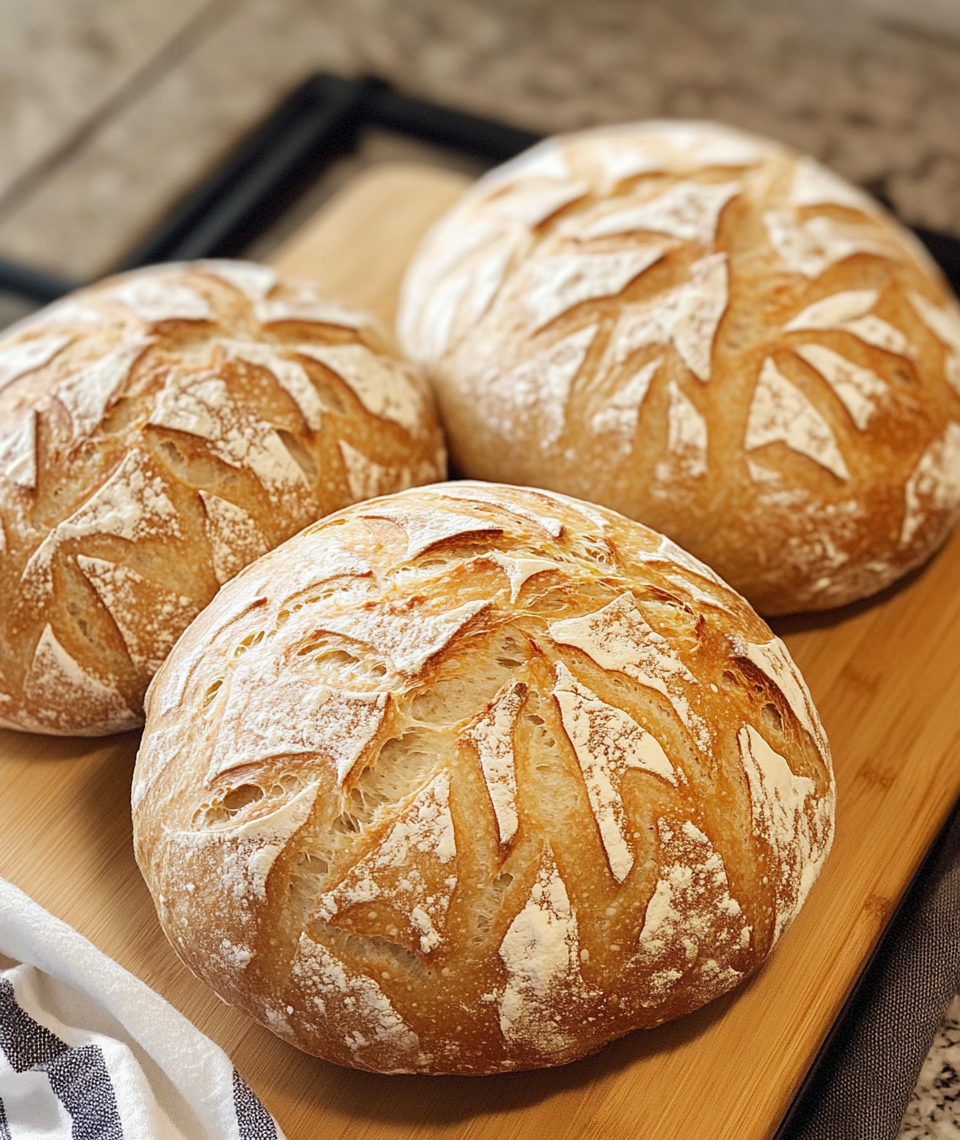Sourdough bread is the perfect balance of simplicity and complexity. With just three ingredients—flour, water, and salt—you create a loaf that’s full of deep flavor, a chewy crumb, and a beautifully crisp crust. The slow fermentation process enhances the taste and texture while making the bread easier to digest. This rustic sourdough is incredibly versatile. Enjoy it fresh with butter, toasted with jam, or as the base for a delicious sandwich. Whether you’re a beginner or an experienced baker, making sourdough at home is a rewarding experience that brings warmth to your kitchen and nourishment to your table.
Full recipe:
Ingredients:
- 500g (4 cups) bread flour
- 100g (1/2 cup) active sourdough starter
- 10g (2 tsp) salt
- 350g (1 1/2 cups) filtered water
- Optional: 1 tbsp honey or sugar (for a slightly softer crumb)
Directions:
- In a large mixing bowl, combine flour and water. Mix until no dry spots remain. Cover and let it rest for 30 minutes (autolyse).
- Add sourdough starter and salt. Mix thoroughly.
- Perform stretch-and-folds: every 30 minutes over the next 2 hours, stretch one side of the dough and fold it over. This helps develop gluten.
- Cover and let the dough ferment at room temperature for 8-12 hours, until it doubles in size.
- Gently shape the dough into a round or oval loaf. Place it into a floured banneton or a bowl lined with a floured towel. Cover and let it proof for another 2-4 hours, or until puffy.
- Preheat oven to 450°F (230°C). Place a Dutch oven inside to heat for at least 30 minutes.
- Carefully place the dough onto parchment paper and score the top with a sharp blade.
- Transfer into the hot Dutch oven, cover, and bake for 20 minutes. Then remove the lid and bake for another 20-25 minutes until golden brown.
- Cool on a wire rack for at least an hour before slicing.
Prep Time: 12 hours (including fermentation) | Cooking Time: 45 minutes | Total Time: ~13 hours
Kcal: 170 kcal per slice | Servings: 1 loaf (8-10 slices)
The Ultimate Guide to Classic Sourdough Bread: A Recipe That Stands the Test of Time
Sourdough bread is more than just a loaf of bread—it’s an ancient tradition, an art form, and a science all in one. This naturally leavened bread has been enjoyed for thousands of years, and today, it continues to be a favorite for home bakers and bread enthusiasts worldwide.
If you’ve ever dreamed of baking your own sourdough at home, this guide will walk you through everything you need to know—from its fascinating history to the unique benefits of sourdough, plus a step-by-step guide to creating a perfect loaf.
A Brief History of Sourdough Bread
Sourdough is one of the oldest forms of bread known to humankind. Unlike modern bread that relies on commercial yeast for quick fermentation, sourdough is made using a wild yeast culture, also known as a sourdough starter. This method dates back to at least 3700 BC in Egypt, where ancient bakers discovered that allowing dough to ferment naturally created a lighter, more flavorful loaf.
For centuries, sourdough was the primary way to bake bread, with bakers cultivating their own yeast and bacteria to develop unique flavors. The gold rush era in California made sourdough even more famous, with miners carrying their starters on long journeys to make bread on the go. Today, sourdough remains a beloved bread for its distinctive tang, airy crumb, and crisp crust.
Why Sourdough Bread is Better Than Regular Bread
What makes sourdough different from store-bought bread? The answer lies in its natural fermentation process, which provides a host of health benefits, superior taste, and improved digestibility. Here’s why sourdough is one of the best types of bread you can make and eat:
1. Naturally Fermented for Better Digestion
Sourdough is fermented using wild yeast and lactic acid bacteria, which break down gluten and phytic acid during the fermentation process. This makes it easier to digest than conventional bread, especially for those with gluten sensitivities. Many people who struggle with regular bread find that they can enjoy sourdough without discomfort.
2. Packed with Nutrients
Unlike commercial bread, which is often stripped of nutrients during processing, sourdough retains essential vitamins and minerals, including:
- B vitamins (important for energy production)
- Iron (needed for healthy blood circulation)
- Magnesium & Zinc (essential for immune function and metabolism)
Because the fermentation process breaks down phytic acid, your body can absorb these nutrients more efficiently.
3. No Artificial Additives or Preservatives
Many store-bought breads contain preservatives, stabilizers, and artificial ingredients to extend shelf life. Sourdough, on the other hand, contains just flour, water, and salt, making it a cleaner, more natural option. The acidity of sourdough naturally preserves the bread, helping it stay fresh longer without added chemicals.
4. Lower Glycemic Index (Better for Blood Sugar)
Unlike highly processed white bread, which causes blood sugar spikes, sourdough has a lower glycemic index (GI). The fermentation process slows down carbohydrate digestion, leading to steadier blood sugar levels, making it a healthier choice for people with diabetes or those watching their sugar intake.
5. Unmatched Flavor and Texture
If you’ve ever tasted a high-quality sourdough loaf, you know there’s nothing quite like it. The fermentation process gives sourdough its signature tangy flavor and airy texture, while the crust bakes to a beautiful golden crisp.
What Makes This Recipe the Best?
With so many sourdough recipes out there, you might wonder: What makes this one special?
Here’s why this recipe is one of the best for home bakers:
1. Simple, Foolproof Ingredients
This recipe uses just four key ingredients:
- Bread flour (for a strong gluten structure)
- Sourdough starter (wild yeast for natural fermentation)
- Salt (enhances flavor and strengthens the dough)
- Water (the essential element for hydration and fermentation)
No unnecessary additives—just pure, wholesome ingredients.
2. Perfect for Beginners and Advanced Bakers
If you’re new to sourdough baking, this recipe provides clear, step-by-step instructions to guide you through the process. But even if you’re an experienced baker, you’ll love the depth of flavor and perfect crust this method produces.
3. Achieves an Artisan-Quality Loaf at Home
You don’t need a fancy bakery to achieve a crispy, golden crust and soft, airy interior. This recipe uses a Dutch oven to replicate professional steam baking, giving your bread the signature texture of an artisan loaf.
4. Long Fermentation for Maximum Flavor
Unlike quick-rise breads, this recipe allows the dough to ferment slowly over 8-12 hours. This slow rise enhances the flavor complexity and develops the perfect chewy crumb.
Step-by-Step Guide to Making Classic Sourdough Bread
Ingredients:
- 500g (4 cups) bread flour
- 100g (1/2 cup) active sourdough starter
- 10g (2 tsp) salt
- 350g (1 1/2 cups) filtered water
Instructions:
Step 1: Mix the Dough
In a large mixing bowl, combine flour and water. Mix until fully incorporated. Cover and let rest for 30 minutes.
Step 2: Add the Starter and Salt
Add the sourdough starter and salt to the dough. Use your hands or a spoon to mix well until combined.
Step 3: Stretch and Fold (Building Gluten)
Over the next 2 hours, perform stretch and folds every 30 minutes to strengthen the dough. Simply stretch one side, fold it over, and repeat on all sides.
Step 4: Bulk Fermentation (First Rise)
Cover the bowl and let the dough ferment at room temperature for 8-12 hours, or until it doubles in size.
Step 5: Shape the Dough
Turn the dough onto a floured surface. Gently shape it into a round or oval loaf.
Step 6: Second Proofing
Place the dough in a floured banneton (proofing basket) or a bowl lined with a floured towel. Let it proof for 2-4 hours until slightly puffy.
Step 7: Preheat the Oven and Bake
- Preheat your oven to 450°F (230°C) with a Dutch oven inside.
- Transfer the dough onto parchment paper, score the top, and place it in the Dutch oven.
- Bake covered for 20 minutes, then uncovered for another 20-25 minutes until golden brown.
Step 8: Cool and Enjoy
Let the bread cool completely before slicing to allow the crumb to set.
Tips for the Best Sourdough Bread
Use High-Quality Flour: Bread flour gives the best structure, but you can experiment with whole wheat or rye for different flavors.
Keep a Healthy Starter: A bubbly, active sourdough starter is key to getting a good rise. Feed it regularly to keep it strong.
Be Patient: Sourdough is a slow process, but it’s worth it! Let the fermentation and proofing take their time.
Use a Dutch Oven: This traps steam, creating a perfect crispy crust. If you don’t have one, place a pan of water in the oven for steam.
Conclusion
Baking sourdough bread at home is one of the most rewarding experiences for any baker. Not only does it fill your kitchen with an irresistible aroma, but it also provides a nutritious, delicious, and healthier alternative to store-bought bread. Whether you’re new to sourdough or a seasoned baker, this recipe will help you create a beautiful, artisan-style loaf every time. So grab your starter, preheat the oven, and enjoy the magic of homemade sourdough!






